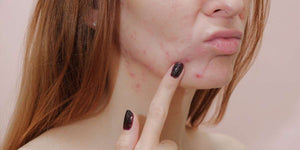These types of zits are caused by an infection of the sebaceous glands and is a type of acne. Blind pimples are irritating and can be painful, as they are located deep under the skin. They can be red, swollen and filled with pus, and can last for days or even weeks. Although they can be uncomfortable and unsightly, there are treatments and preventative measures that you can take to treat and prevent future breakouts.
- How to recognize if you have a cystic pimple
- Types of underground pimples
- What causes blind pimples?
- How to treat blind pimples?
- OMMA Cosmetics Pimple Patches for Underground Pimples
- Tips for preventing blind pimples
How to recognize if you have a cystic pimple
Deep pimples are usually red and swollen, and sometimes pus-filled bumps. Because of their location deep under the skin they can be very difficult to treat. These hard pimples are often accompanied by inflammation, tenderness, and even pain. They often appear without heads and are commonly referred to as “underground pimples”.
Blind zits can range in size from small, hard bumps under the skin to large, inflamed, pus-filled bumps that can be painful to the touch. These inside pimples can occur anywhere on the body, but are most commonly found on the face, neck, back, shoulders, and chest.
Blind pimples can be difficult to diagnose as they are not always visible. If you suspect you may have a blind pimple, it is best to consult with a dermatologist or skin care specialist who can assess the area and provide a diagnosis and treatment plan.
Your zit-free emergency kit for reducing early-stage painful & deep pimples, 18pcs
Types of underground pimples
Ingrown pimples and black pimples are two different types of pimples that can form on the skin. An ingrown pimple is when a hair follicle becomes clogged and a bump forms under the skin. They can be itchy and painful and appear as a red or pink bump on the skin.
Black pimples are different from ingrown pimples in that they are caused by an accumulation of oil, dead skin cells, and bacteria. They appear as black or dark brown bumps on the skin and can be painful to the touch.
Infected acne can leave scars if left untreated, so it’s best to consult a doctor if you get recurrent skin infections. A green pus pimple is an infected pimple that is filled with a yellowish-green pus. This type of pimple is caused by an infection that has been left untreated and can be very painful. The infection can be caused by bacteria, fungi, or parasites. Green pus pimples are often accompanied by redness, swelling, and tenderness. In some cases, the pimple may have a foul smell. If you notice a green pus pimple, it is best to consult a doctor or dermatologist as soon as possible to seek treatment. The doctor may prescribe antibiotics or other medications to help treat the infection.
Cystic acne is a form of acne that affects the skin on the face, but especially around the jaw line and chin. It consists of large bumps filled with pus that can be extremely painful. In fact, cystic acne is often called "the world's worst pimple," because it can take weeks to get rid of it. The severity of this type of acne depends on how much oil your skin produces and how much dead skin cells build up within your pores.
These types of pimples with no heads can be treated with over the counter medications and/or topical creams. You can also use microcrystal pimple patches.

Your zit-free emergency kit for reducing early-stage painful & deep pimples, 18pcs
What causes blind pimples?
Blind pimples can be caused by a variety of factors, including hormones, bacteria, and genetics. In some cases, blind pimples can be a sign of an underlying health condition.
The most common cause of blind pimples is usually the same as for all other forms of acne; a combination of hormones, excess oil production, bacteria, and inflammation. When the sebaceous glands become blocked with excess oil, dead skin cells, and dirt, it can cause a build-up of bacteria which can lead to inflammation. This can cause the skin to become swollen and tender, and a blind pimple can form.
Cystic acne is usually caused by bacteria infecting the hair follicle, which causes inflammation in the area. Although it's not contagious, you should see your doctor if you think you have cystic acne because it could lead to more serious issues if left untreated. Most cases of cystic acne are caused by genetics, but they can also be triggered by diet or stress.

Your zit-free emergency kit for reducing early-stage painful & deep pimples, 18pcs
How to treat blind pimples?
Treating blind pimples can be tricky, as they are deep under the skin and difficult to reach. The best way to treat a blind pimple is to use topical medications and treatments that can help reduce inflammation, reduce bacteria, and unblock the sebaceous glands.
Salicylic acid is a common topical treatment for acne, including blind pimples. It works by unblocking the sebaceous glands and can help to reduce inflammation.
Benzoyl peroxide is another topical treatment that works by killing bacteria and reducing inflammation. Prescription medications such as antibiotics and retinoids can also be used to treat blind pimples. Antibiotics can help to reduce the number of bacteria on the skin and reduce inflammation, while retinoids can help to unblock the sebaceous glands and reduce inflammation. In some cases, a corticosteroid injection may be used to reduce inflammation and reduce the size of the blind pimple. This is usually only done in severe cases, as corticosteroids can have serious side effects.
OMMA Cosmetics Pimple Patches for Underground Pimples
I've tried a lot of different products for my acne, and I can say that the pimple patches created for OMMA Cosmetics have been the most effective for me. They're better than any other pimple patches on the market because of the unique active ingredients blend they are infused with.
Your zit-free emergency kit for reducing early-stage painful & deep pimples, 18pcs
If you're struggling with deep pimples, I highly recommend giving OMMA Cosmetics microcrystal patches a try.
Here are some tips on how to treat blind pimples at home and prevent future breakouts:
- Cleanse and Exfoliate: Using a gentle cleanser and exfoliating your skin regularly can help to prevent further breakouts. Exfoliating helps to remove any dirt, oil, and dead skin cells that may be clogging pores and causing acne.
- Use a microcrystal pimple patch.
Microcrystal pimple patches are a great way to treat blind pimples. Blind pimples are those that form deep within the skin, and are often difficult to treat with topical medications.
Microcrystal pimple patches provide a safe and effective way to treat these types of pimples. The patches contain microscopic crystals, which deliver powerful active ingredients deeper into the skin and also help to absorb the sebum and dirt that caused the blind pimple.
The patches also help to reduce inflammation, redness, and prevent further infection. The patches are easy to use and can be applied directly to the affected area. They are hypoallergenic and cause no irritation to the skin. With regular use, they can help to reduce the size of the blind pimple, and even prevent future breakouts.

Your zit-free emergency kit for reducing early-stage painful & deep pimples, 18pcs
- Use Medicated Creams Using a medicated cream or ointment can help to reduce inflammation and reduce the size of the pimple. These creams usually contain benzoyl peroxide, salicylic acid, or sulphur, which can help to reduce inflammation and unblock pores.
- Use Warm Compresses: Applying warm compresses to the area can help to reduce inflammation and bring pus to the surface. This can help to reduce the size of the pimple and make it easier to treat.
- Use Tea Tree Oil: Tea tree oil is a natural antiseptic that can help to reduce inflammation and treat pimples. It can also help to reduce the size of the pimple and reduce redness.
- Don’t Pop or Squeeze: It can be tempting to try to pop or squeeze a blind pimple, but this can cause further inflammation and can spread bacteria. It is best to avoid touching or picking at blind pimples. This is where pimple patches come in handy. Pimple patches are such a lifesaver. They're the best way to get rid of pimples without having to break out the makeup remover or scrubbing your face raw. All you have to do is apply them directly to the affected area and leave it on for about 12 hours. When you remove it, you'll be left with a clean, clear face—no more red spots or bumps! It's so satisfying to see how well they work.
- Change Your Diet: Diet can play a role in acne breakouts. Eating a healthy, balanced diet that is low in sugar and processed foods can help to reduce the risk of breakouts.
- Get Regular Exercise: Exercise can help to reduce stress and reduce the risk of breakouts. Exercise can also help to flush out toxins.
Tips for preventing blind pimples
Although treating blind pimples can be difficult, there are some steps you can take to help prevent them from occurring in the first place. The most important thing you can do is to keep your skin clean and free of dirt and bacteria. This means washing your face twice a day with a gentle cleanser, and avoiding harsh or abrasive scrubs or exfoliation.
You should also avoid touching your face, as this can transfer dirt and bacteria to the skin and can lead to breakouts.
If you have oily or acne-prone skin, you may want to try using an oil-free moisturiser to help keep your skin hydrated without causing breakouts.
In addition, it is important to avoid using products that contain heavy fragrances or harsh chemicals, as these can irritate the skin and can lead to breakouts.

Your zit-free emergency kit for reducing early-stage painful & deep pimples, 18pcs
Blind pimples can be painful and difficult to treat, but there are steps you can take to reduce the risk of future breakouts. Keeping your skin clean, avoiding touching your face, and using oil-free moisturiser can help to prevent blind pimples. If you do develop a blind pimple, there are topical treatments and medications that can help to reduce inflammation and treat the area. It is important to consult with a dermatologist or skin care specialist if you are concerned about blind pimples, as they can provide a diagnosis and treatment plan.
Hugs!
Adrienne | Co-founder of OMMA Cosmetics
Photo sources: Unsplash, OMMA



